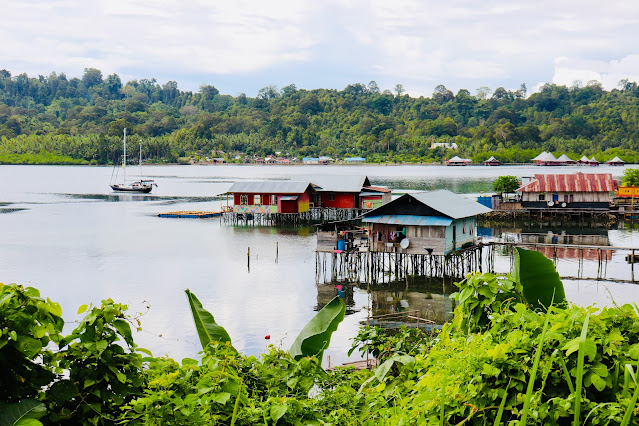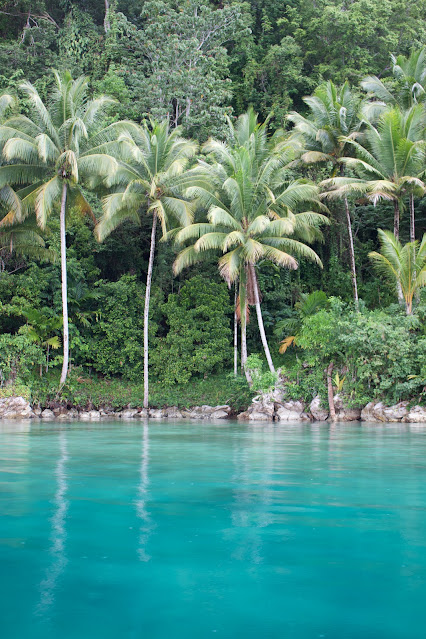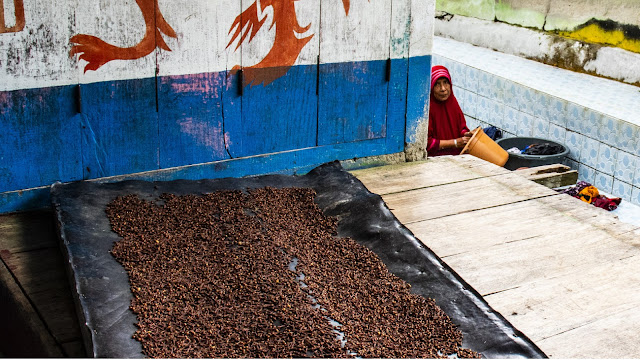Once the favourite Dutch colony – for precious spices that grew nowhere else on earth, today, Maluku Region is an attractive travel destination, when it comes to yachting and scuba diving. The archipelago includes thousands of inhabited and uninhabited volcanic islands, small isles and tiny islets. What really stands out though, is the scenery in Central Maluku. The chain of forested mountain islands is fringed by immaculate beaches and secluded bays, turquoise lagoons with overwater bungalows, virgin coral reefs; and all that is concluded with perfectly-shaped volcanoes in the background – a perfect holiday hub, if you can get there!
Back in the days, the famed ‘Moluccas’ was a place where a great wealth grew on the trees – quite literally. Mace, nutmeg and cloves were found nowhere else in the world, which reinforced the Dutch colonial power. These days, even though the people still harvest these commodities, it is rather the Polynesian look that draws the visitors. Indeed, some of the islands in Central Maluku could easily compete with Tahiti.
 |
This is an image of Ora Beach our next stop don’t miss it! |
We will be travelling the island chain from Kei Kaceil, day hoping to the largest island in the region, Seram. It lies north of the well know city of Ambon, a mountainous island Seram is home to the Malukus Regions highest peak, Mount Binaiya (3027m). It is also a major karst area and has Indonesia’s deepest cave Hatu Saka. Pulau (Island) Seram, although it ranks in the 100 biggest islands in the world, is one of the least known. We’re on the north coast of Seram, which at 340 kilometres long we won’t be sailing in a day. It is probably an Indonesian island you’ve never heard of. One of the pure joys of our lifestyle is that we can choose to venture to little known areas and discover them for ourselves.
With a rugged interior of jungle-swathed mountains, it was home to headhunters until the middle of the 20th century. As part of the Wallacea region between Asia and Australia Seram is an extremely diverse region where plants and animals from both continents can be found. Included in the Manusela National Park is endemic bird species so there is plenty on offer for nature lovers and adventures alike. Cockatoos, parrots, and hornbills are just a few of the exotic bird species found in the forests, not to mention wild durians falling off the trees.

Established in 1997 the park is approximately 1890 square kilometres and includes mountains, coastal lowlands, swamps, caves and karst formations. One of the jewels in it’s crown is the beautiful Bajau village of Sawai. With it’s amazing backdrop of shear mountain cliffs that drop from the lofty clouds above into the crystal clear waters below this magical village raises itself out of the water and floats on the mirrored sea. It is totally enchanting. It is one of the most off the beaten track places you will find. Very few visitors make it this far. But for those who do make the arduous journey you are met with what is a unique opportunity to meet the beautiful Bajau tribe in a village removed from the tourism spotlight.
As early as the 15th century, various bands of bajau people migrated between the Phillipines and Indonesia. The Bajau people who inhabit Sawai arrived on their floating homes from the Sulu Islands region in the Southern Philippines. And because of their nomadic sea life, this tribe eventually spread into the waters of Malaysia, and Brunei. You can now find villages in most areas, from Eastern Indonesia, such as in the waters of Maluku, Raja Ampat, Sulawesi and to the northern part of Kalimantan.
In Teluk (village) Sawai the Bajau people have built simple stilt houses using the coral reef as the foundations, these homes sit proudly above the still waters where they continue to be a seafaring tribe. Their “floating” homes keep them connected to the sea at all times, though their distance from conventional mainland also keeps them disconnected from modern civilization. Perhaps, this divide is part of what allows them to maintain their way of life and ancestral traditions despite the influences of globalization.

As we started our journey down the “fiord” type entrance towards the village, the weather started to close in. Visibility dropped considerably. There isn’t a wet or dry season in these parts it either rains or it doesn’t. We just happen to arrive when the fog and drizzle rolled in. We had studied the charts both Navionics and the satellite images of where we thought a anchorage spot might be. Rob kept saying to me, don’t be disappointed if we can’t anchor here. My thoughts were, we haven’t even seen the place yet, let’s just wait and see. Well if you want to believe Navionics we could of anchored anywhere. But when you see this place …….
 |
| The weather closed in with rain and thunder. |
As we slowly edged our way all the way to the end of the “fiord” the weather started to clear. Immediately, I was struck by the pure magic of the place, and the magnitude of those cliffs and we couldn’t see the top of them still cloaked in cloud.
There is no way we are going to find shallow water! The shallowest I had seen was 60 + meters. Rob just kept shaking his head ….. I asked if we could just try over there by some houses, as I nudged the bow of Our Dreamtime in, I called out to Rob “20m 16m quick let’s get the anchor down. Against Robs better judgement we turned and dropped the anchor. The weather was to be 0knots for the next week. We were at the end of a fiord with little to no tidal run. Perfect. We dropped 50 meters with the thought that it should keep us rock solid.
We literally stood on the bow of Our Dreamtime, in awe of this place …. You could not wipe the smiles off our faces. The video was going the phone cameras were doing panorama’s, we were taking selfies, we had found paradise. This is what we had come to Indonesia for, to discover the true Indonesia, away from the Kuta Bars and the beach scene of Bali. This was authentic, this had purpose.
Wow we couldn’t wait to explore! But even with the excitement rushing through our veins, it was late so we decided to wait until morning.
Sawai Village, is one of the many destinations in the Manusela National Park. The waters are calm and crystal clean. The village is stunning with a backdrop of mountains smothered in the most beautiful dense rainforest that comes down to meet the mirrored sea. It really is an enchanting vista. It’s the oldest bajau villages in Maluku dating back 400 years.
Not only is the mountainous setting awe inspiring there are several beautiful small islands surrounding the entrance to the “fiord” These islands add to the beauty of the sea surrounding Sawai, with their white powder beaches and coral fringing reefs.
Arriving in the village the next day we weren’t mobbed by the teenagers asking for selfies like we had been in the Kei Islands. Everyone was reserved, just going about their daily chores. There were sideways glances and a few laughs, but generally it was still a very welcoming feel, even if it wasn’t flocking mobs. We asked politely if we could take “Photo” where there was always a smile given. We wandered the streets seeing new homes being built, women cooking in a communal outside kitchen. Children running around and laughter ringing out. All was very content and happy in this very simple way of life. The call to prayer started which ebbed all other sounds and a sense of calm swept over the village.

A unique feature of this village is their “giant swimming pool”. This pool is a source of fresh water for the village and it is located in the centre. The fresh water springs from the stone boulder at the bottom of the cliff face in the middle of the pond. The sparkling water in the pool is crystal clear. The tribe have built a tiled pool with steps leading into it. It continuously flows through the village creating a centre point for all matter of chores. We understand early in the morning it is bathing time. Then there is a period of time that is set aside for wash of clothing, however it seemed like the children had all day to swim. Some wanting us to join them in the cool mountain spring water.

Over the years the village has evolved. With the road now cut through the National Park, they do receive some tourism in the form of adventurers who wish to hike in the National Park or wanting to climb Mount Binaiya. Small home stays have opened and we ate at one very small resort offering beautiful food served on decks over the water. We could of literally stern-to-moored Our Dreamtime off the balcony.
A couple of the biggest changes for the village is electricity and concrete. The village enjoys 8 hours of power from the national grid each day and the areas closest to the island now have cement pathways. However communication to the outside world was non existent as there was no internet, thank goodness for our Starlink lol.
There was very little English spoken so our Google translator got a workout. We sat in a beautiful little warung (eatery) overlooking the “anchorage”. We asked the owner through Google, how many boats/yachts had she seen come to Sawai. She thought for a moment and then put one finger up, then pointed to Our Dreamtime laying at anchor.
Our floating home of 12 meters had brought us to somewhere very special indeed. This truly mystical place, filled with simple beauty, represents the ability of humans to live in peace with their environment.

I
Thank you to all who support us through watching our videos, reading our blogs or who step up and support us though
Patreon and
Ko-Fi. You inspire us everyday to be creative 🙌
You can help us out and support our creative work for FREE.
By watching, 👍, 🔔, Subscribing, Commenting and best of all Sharing this video or blog with your friends
If you would like to make a donation towards our creative work, you can by heading over to Ko-Fi they take no fees so the support goes directly into helping us buy and upgrade equipment
Do you want more?
Patreon gives you that … you get behind the scenes updates,
Patreon only photos and posts, you can watch our
episodes ad free and before they go public … you get it first!
Another way of support is through buying from our store.
Checkout the range of books we have available













































































